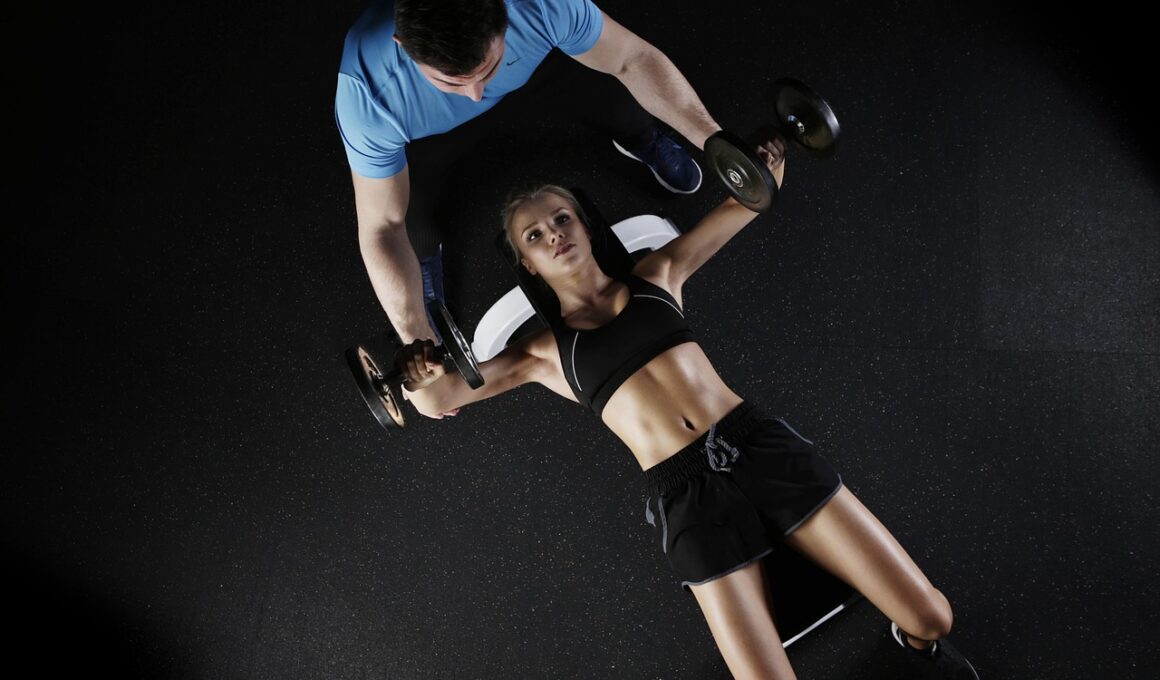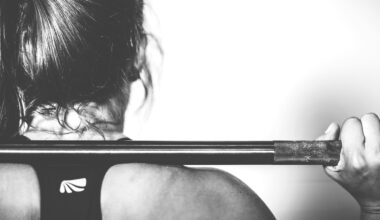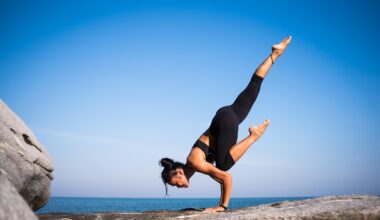Integrating Plyometric Bodyweight Moves with Traditional Weight Training
Combining plyometric bodyweight exercises with standard weight training routines can enhance overall athletic performance. Plyometric exercises, like jump squats or burpee variations, focus on explosive strength and speed. Weight training, on the other hand, targets strength and muscle hypertrophy. When merged, these two forms of training can significantly improve power output and efficiency. Understanding the biomechanics of both training modalities is crucial to seamless integration. This synergy not only boosts physical capabilities but also keeps workouts engaging and diverse. A well-balanced approach can yield maximum results, enhancing both cardiovascular and muscular fitness while also reducing injury risks. Athletes seeking to refine their movements can greatly benefit from this combination, as they learn to control their body weight effectively first. Moreover, increased joint stability and activation patterns can emerge from integrating these modalities. Therefore, structuring workouts to blend both types effectively can help in realizing these fitness goals. Not only will this save time spent working out, but it can also provide a holistic exercise routine tailored to individual needs. A well-planned regimen incorporating plyometric movements may provide competitive advantages in sports, especially those requiring speed and agility.
The Benefits of Plyometric Integration
Plyometric exercises are key to enhancing explosive power, making them invaluable in sports training. When combined with resistance training, they create a comprehensive workout experience that fosters both strength and agility. This integration offers unique benefits that are challenging to achieve with traditional methods alone. Athletes who incorporate plyometric routines into their weight training often see improved performance metrics. This can include better sprint times, quick changes of direction, and even vertical leap increase. Notably, these exercises help in developing fast-twitch muscle fibers, which are essential for explosive activities. Engaging in plyometric training cultivates neuromuscular efficiency, allowing the brain to communicate more effectively with muscles. Thus, the coordination and timing of movements are enhanced, translating to more effective execution in sports. It’s crucial to balance intensity, volume, and recovery when integrating these exercises to avoid injury. Finding this balance is essential for athletes dedicated to maximizing their performance. Moreover, combining these workouts keeps routines fresh and motivational while pushing one’s physical boundaries. Trying various plyometric exercises alongside free weights can lead to exciting workout variability and progressive improvements.
The integration of plyometric exercises into a weight training program requires careful planning and execution. Establishing a solid strength base through traditional weight training builds a firm foundation for more explosive movements. Athletes should begin gradually, introducing plyometric exercises using their own body weight before incorporating weights. Starting light ensures proper technique and reduces the risk of injuries during intensive training sessions. Suggested plyometric exercises include box jumps, clap push-ups, and lateral bounds. Each movement targets different muscle groups while promoting efficient movement patterns. It’s vital to focus on maintaining proper form to optimize benefits. A common approach is to alternate between plyometric movements and resistance training sets. This allows athletes to recover while keeping heart rates elevated, effectively enhancing cardiovascular fitness. For example, a routine might involve doing jump squats followed by weighted squats for a maximal pump. Using sufficient rest intervals between plyometric efforts is essential for full recovery and optimal performance. This technique not only improves personal bests but also breaks plateaus in strength training routines. Gradual progress in both plyometric and weight training demands attentiveness, ensuring the integration leads to effective adaptations.
Workout Structure Strategies
To successfully integrate plyometric exercises with traditional weight training, a structured approach is paramount. One effective strategy is the super-set technique, where a plyometric movement is immediately followed by a heavier resistance exercise. For instance, performing a set of explosive push-ups, then transitioning into bench press repetitions can be beneficial. This keeps the muscles engaged and maximizes workout efficiency while enhancing muscle endurance. Another strategic approach is circuit training, where participants cycle through multiple stations, alternating plyometric and weight training tasks. This method encourages cardiovascular endurance while targeting various muscle groups, preventing fatigue from a single muscle group. Monitoring and adjusting workloads, frequency, and intensities during plyometric exercises ensure optimal performance outcomes. Additionally, balancing the repetitions and the load used in weight training helps prevent overtraining. Utilizing data tracking tools can optimize training adjustments over time. Evaluating performance metrics is essential to analyze progression. Consider utilizing rest days effectively, incorporating mobility and flexibility work between high-intensity training sessions. This longevity-focused strategy supports recovery and resilience, ultimately enhancing overall productivity and success in both strength and explosive performance.
The blend of plyometric movements and weight training serves to amplify physical resilience. Engaging in this hybrid training system supports improved joint health and functional movement patterns while reducing injury risk. Research indicates that athletes who incorporate plyometrics develop decreased rates of injury and increased longevity in their sports careers. While explosive movements place stress on joints, building resilience through targeted strength training mitigates potential adverse effects. Focusing on foundational strength helps in protecting tendons, ligaments, and muscles during high-impact movements. Athletes should also prioritize proper warm-up routines that incorporate mobility drills to prepare the body for demanding plyometric exercises. These readiness routines can include dynamic stretches that lead into explosive movements. Consistently practicing these preparations allows the body to adapt over time, enhancing overall performance while reducing injury risk. Recovery strategies play a pivotal role in an athlete’s success. Using foam rollers and engaging in post-workout stretches can help facilitate recovery and maintain muscle elasticity. Prioritizing nutrition and hydration cannot be understated as they contribute to overall exercise recovery. Creating an adaptable routine that accounts for rest, nutrition, and joint health will lead to sustained success and performance enhancement.
Measuring Progress and Adjusting Training
Continuously measuring and adjusting training outcomes ensures the integration of plyometric and weight training is effective. Key performance indicators (KPIs) should be established to track improvements over time. Based on these metrics, adjustments can be made to enhance physical capabilities. Key KPIs may include vertical leap heights, sprinting speed, and resistance amounts lifted. Observing trends within these metrics helps to identify areas needing refinement and provides motivation to push harder. Athletes can establish goals centered around these indicators to sustain motivation. Using technology, such as apps or wearable devices, may aid in tracking these metrics effectively. Documenting workout sessions allows participants to see their progress. Regular evaluations of performance and fitness goals enable athletes to understand which strategies are working best. Additionally, incorporating feedback from coach insights can drive meaningful adjustments. Flexibility in workout designs is crucial to ensure both continued improvement and the enjoyment of the training process. If results plateau, modifying sets, reps, or incorporating new exercises keeps activities engaging and productive. By consistently evaluating progress and implementing new challenges, an athlete can maximize gains from the integrated training forms while maintaining excitement throughout the fitness journey.
As athletes develop their approach to integrating these two training methods, community support can provide inspiration and motivation throughout the process. Engaging with training partners encourages accountability and helps maintain enthusiasm for workouts. Individuals can share progress, challenges, and tips that enhance their experiences. Community events, such as local competitions, can present opportunities for friendly challenges while fostering camaraderie. Online platforms and forums can also be beneficial resources, where individuals exchange ideas and encouragement. Finding workout buddies with similar performance goals further boosts morale, pushing each other to reach new heights. Additionally, participating in group classes that combine both plyometric and weight training techniques can offer new insights and variety. Learning from experienced trainers can enhance knowledge of movement specifics while ensuring proper techniques are utilized in workouts. Community engagement builds a support system that nurtures commitment to personal fitness journeys. Recognizing the role teamwork and support play in fitness helps keep motivation high. Ultimately, embracing the element of community within fitness cultivates an enriched experience, making the blend of plyometric work and weight training not only effective but enjoyable.
In conclusion, integrating plyometric bodyweight moves with traditional weight training poses multiple benefits for athletes and fitness enthusiasts alike. When executed correctly, this approach fosters improved strength, power, and agility, significantly enhancing athletic performance. Individuals are encouraged to experiment with various exercises to discover which combinations work best for their unique goals. Taking the time to assess progress and adjust accordingly ensures continuous improvements and goals remain achievable. Furthermore, considering the importance of community support can greatly enhance motivation and accountability within any training regime. Mutual encouragement among individuals pursuing fitness goals creates an atmosphere filled with energy and drive. Prioritizing safe training methods remains essential, aiming for sustainable gains over time. Proper recovery and nutrition should not be overlooked, with these factors contributing to overall health and performance. The joy of personal growth fuels motivation, allowing athletes to challenge themselves continually and refine their skills. Understanding the balance between plyometric and traditional weight training will determine continued success in achieving desired results. By embracing this multifaceted training approach, individuals can experience profound changes in their physical capabilities, ultimately leading to fulfilling and successful fitness journeys.


